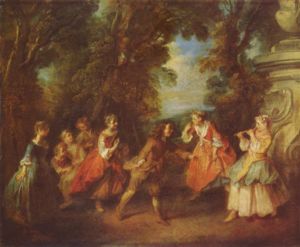
Nicolas Lancret
Encyclopedia

Paris
Paris is the capital and largest city in France, situated on the river Seine, in northern France, at the heart of the Île-de-France region...
, and became a brilliant depicter of light comedy which reflected the tastes and manners of French society under the regent Orleans.
His first master was Pierre d'Ulin, but his acquaintance with and admiration for Watteau
Antoine Watteau
Jean-Antoine Watteau was a French painter whose brief career spurred the revival of interest in colour and movement...
induced him to leave d'Ulin for Gillot
Claude Gillot
Claude Gillot was a French painter, best known as the master of Watteau and Lancret. He had Watteau as an apprentice between 1703 and 1708....
, whose pupil Watteau had been. Lancret, who remained a pupil of Gillot from 1712-1713, was heavily influenced by the older painter, whose typical slender figures can be found in many of his pupil's younger works. Two pictures painted by Lancret and exhibited on the Place Dauphine
Place Dauphine
The Place Dauphine is a public square located near the western end of the Île de la Cité in the first arrondissement of Paris. From the "square", actually triangular in shape, one can access the middle of the ancient bridge called the Pont Neuf. The bridge connects the left and right banks of the...
had a great success, which laid the foundation of his fortune, and, it is said, estranged Watteau, who had been complimented as their author. In 1718 he was received as an Academician, from thereon becoming a very respected artist, especially amongst the admirers of Watteau. He completed works to decorate the Palace of Versailles
Palace of Versailles
The Palace of Versailles , or simply Versailles, is a royal château in Versailles in the Île-de-France region of France. In French it is the Château de Versailles....
, while his style was later to prove popular with Frederick the Great. Lancret's populairty was reflected by the decision to make him a councillor at the Academie in 1735.
Lancret's work cannot now, however, be taken for that of Watteau. In drawing and in painting his touch is often considered intelligent but dry; art historian Michael Levey remarked that Lancret was 'no poet by a charming essayist'. Lancret's characteristics are due possibly in part to the fact that he had been for some time in training under an engraver.
The number of his paintings (of which over eighty have been engraved) is immense; he executed a few portraits and attempted historical composition, but his favourite subjects were balls, fairs, village weddings and so forth. The British Museum
British Museum
The British Museum is a museum of human history and culture in London. Its collections, which number more than seven million objects, are amongst the largest and most comprehensive in the world and originate from all continents, illustrating and documenting the story of human culture from its...
possesses an admirable series of studies by Lancret in red chalk, and the National Gallery, London
National Gallery, London
The National Gallery is an art museum on Trafalgar Square, London, United Kingdom. Founded in 1824, it houses a collection of over 2,300 paintings dating from the mid-13th century to 1900. The gallery is an exempt charity, and a non-departmental public body of the Department for Culture, Media...
, shows four paintings—the "Four Ages of Man" (engraved by Desplaces and l'Armessin), cited by d'Argenville amongst the principal works of Lancret. It is generally considered that the artist produced his best work towards the latter end of his life, displaying, in the minds of several art historians, an increasing ability to create a sense of harmony between art and nature, as in Montreir de lanterne magique, and a willingness to lend his, now bulkier, figures a firmer place in his compositions. These changes displayed the influence of later Watteaus like L'Enseigne de Gersaint. Lancret's last painting, Family in a Garden, The National Gallery, is considered by Levey to be his 'masterpiece'. The scene, which depicts a family taking coffee, has an intimacy and hint of humour that are considered captivating. The work's flowing lines, Rococoesque harmony of pastel colours, painterly style and charming subject matter (of a wide eyed young girl, surrounded by her happy family and natural, yet un-threatening setting, trying her first taste of coffee) are seen to display a delicate sense of vitality and freshness that anticipate the works of both Thomas Gainsborough
Thomas Gainsborough
Thomas Gainsborough was an English portrait and landscape painter.-Suffolk:Thomas Gainsborough was born in Sudbury, Suffolk. He was the youngest son of John Gainsborough, a weaver and maker of woolen goods. At the age of thirteen he impressed his father with his penciling skills so that he let...
and Jean-Honoré Fragonard
Jean-Honoré Fragonard
Jean-Honoré Fragonard was a French painter and printmaker whose late Rococo manner was distinguished by remarkable facility, exuberance, and hedonism. One of the most prolific artists active in the last decades of the Ancien Régime, Fragonard produced more than 550 paintings , of which only five...
.
In 1741 he married a grandchild of Boursault
Edmé Boursault
Edmé Boursault was a French dramatist and miscellaneous writer, born at Mussy l'Evéque, now Mussy-sur-Seine ....
, author of Aesop at Court.

